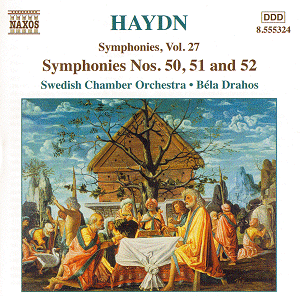Naxos
continues its Haydn symphony series with Nos. 50-52. The cycle
is being recorded by three orchestras – the present one, the Esterházy
Sinfonia and the Northern Chamber Orchestra.
It
is always interesting to hear lesser-known Haydn symphonies: it
reminds one of the composer’s unfailing inventiveness. Nos. 50-52
date from the early 1770s. Of particular interest is No. 51 in
B flat, with its perilous horn arts. The first horn is often high
up in the stratosphere, while the second explores the depths of
the instrument’s range. The vigour of the opening Vivace is nicely
projected, but it is in the Adagio that the horn parts come into
their own. The first horn is credited on the back cover (Bengt
Olerås), and with some justification. His vibrato is tasteful,
and he (somehow) manages not to scream his way up to the top notes,
remaining instead in full control of his instrument. Agility is
demonstrated in the Menuetto, which still remains cripplingly
high. Exciting listening, certainly. The vigour of the Swedish
forces is convincing, as is their robust approach to the finale.
Symphony
No. 50 in C begins with a Maestoso introduction. The ensuing Allegro
is pointed and lively, the phrasing appropriately suave on occasion.
A pity the Andante moderato seems over-long, though. The performance
is civilised, if on the pedestrian side – the players see to wake
up more for the cheeky, perky Menuet (again, high horn parts provide
quite a challenge).
No.
52 in C minor is a characteristically Sturm und Drang piece,
restive and dramatic, with lots of energy on show in the first
movement. The extended slow movement (at 9’16, the longest single
movement on the disc) balances the events of the first; the vigour
of the finale provides an uplifting close to the disc. The prevailing
seriousness of intent casts its shadow over the Menuetto, which
is subdued and almost melancholic in intent. The Swedish Chamber
Orchestra responds by lavishing this movement with a great deal
of care.
Throughout,
Béla Drahos chooses convincing tempi. Textures are carefully
balanced and everything is beautifully tailored in a generally
non-inteventionist manner. Any one of these three symphonies will
bring pleasure.
By
the way, the attractive cover illustration, ‘Phileon and Baucis’
(c1500) by Bartolomeo Braantino (1450/55-1536) ties in nicely
with the musical offerings: Haydn produced a piece of the same
name that was contemporary with these symphonies (it has been
suggested No. 50 was played around this time). A well-produced
product, then, that should give a fair amount of pleasure as well
as filling in a few gaps in the Haydn symphony department.
Colin
Clarke
